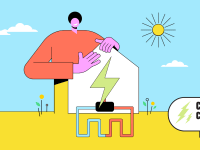How to heat the energy-efficient home we all aspire to have
High energy costs don't fly
Products are chosen independently by our editors. Purchases made through our links may earn us a commission.
If you live in a climate where temperatures fluctuate, or are just plain cold, featuring less than ideal snowy and windy weather conditions, the weak points in your home will come screaming to the surface, like cracks where cold air seeps in or drafty windows that aren’t fully insulated against the weather.
With the high energy costs of electricity, oil, and gas, you may see more expensive heating bills as temperatures drop. As climate change is an ongoing conversation, as well as keeping money in your pocket, have you ever considered alternative forms of heating your home?
Solar power is making a statement in areas of the United States. There are also less mainstream technologies that consumers are exploring, including wind power and geothermal energy.
While you can prepare financially for rising energy costs, it’s worth exploring sustainable alternatives. In the meantime, consider fixing your home’s problem areas and think about heating your home in a more environmentally friendly way.
We spoke with Professor Jeff Bielicki at Ohio State University, where he is part of the Energy Sustainability Research Laboratory. We discussed a variety of ways to heat homes, including geothermal, solar, electric, wood-burning, gas, wind, and oil.
While it’s important to note there are a lot of nuances to any energy conversation, some forms of energy are better than others. Bielicki suggests people get rid of home heating oil if they still rely on it, which may be more common in rural areas.
Consider transitioning your home to solar power or geothermal energy for heating and cooling
Solar power
These technologies are an efficient way to heat or cool your home. Plus, they are Mother Earth-approved.
Using solar panels, you can create and use your own electricity (opposed to purchasing it through a utility company).
When you install solar panels on your property or roof, the panels collect sunlight, which transforms into energy for your home.
Bielicki notes, “Solar is a great idea, and, in fact, the Inflation Reduction Act has a lot of incentives for electric vehicles and solar tax credits, reducing the cost of installation.”
Solar is a great source of energy because the fuel (sunlight) is free. However, you can only get that fuel when the sun is shining. You will probably also want to have a battery storage system so you can access the stored energy in the evenings and early mornings, for example.
Bielicki also adds that solar can’t provide all the energy for your home though; you’ll need another source as well.
Geothermal energy
Another environmentally friendly way to heat your home is by using geothermal heat pumps.
“These are great, too,” says Bielicki. “They’re quite efficient, have lower operating costs, and provide heating and cooling. You’ll need to contact an HVAC company to have a geothermal pump installed, but imagine it as similar to an exterior air conditioner.”
Reviewed’s chief scientist, David Ellerby, PhD, adds, “Geothermal heat pumps either need a lot of land to lay out shallow heat exchange pipes or a very deep drill hole. The geology needs to be right, too.”
Alternatively, if geothermal energy is not an option, Ellerby suggests an air source heat pump. “These are more like an AC unit. They're not quite as efficient as geothermal, but they're still a very good option and there are fewer barriers to installation.”
Wind power
If you’ve been driving down a highway or you’ve passed one of a few major wind farms in California, New Mexico, or Oklahoma, you may be familiar with the towering wind turbine. These harness the wind and use it to create power on a large scale.
While these are ideal for communities at large, wind power is not something that is ready to be transitioned for residential purposes. Bielicki says that it’s just not feasible for most homes, although it could be an option for rural areas and farmers.
Is using wood-burning or pellet-burning stoves effective and eco-conscious?
You may think of space heaters as a supplement to your home’s heat or a temporary solution. However, space heaters will use electricity and lead to a higher bill.
Many people also consider installing a free-standing, wood-burning stove or pellet stove if they have the space for one; both are effective producers of heat. A pellet stove is less intensive, and it generally doesn’t create as much heat as a wood-burning stove might.
However, homeowners need to account for the smoke and emissions that are being sent into the air when burning with pellet and wood stoves. Some scientists warn that “favoring wood could actually boost carbon emissions, not curb them, for many decades, and that wind and solar energy—emissions-free from the start—are a better bet for the climate.”
Scientists also worry that policies promoting wood fuels could unleash a global logging boom that trashes forest biodiversity in the name of climate protection. A number of European environmental groups also warn about the downsides of burning wood, saying that pushing wood as a renewable energy source is misconceived when it comes to climate change mitigation. Burning wood produces more carbon dioxide than burning coal, oil, or gas, and there are concerns about additional air pollution as well.
Increase the energy efficiency of your home by giving it an energy audit
An energy audit gives you knowledge and information about your home, which can lead to increasing your energy efficiency.
An energy audit is specific to your home and can help you find better solutions to what you currently use when it comes to heating and insulating your home. This leads to the resolution of inefficiencies and can provide you with rebates for new equipment or repairs.
Best of all, an energy audit is usually free. Find out how you can make an appointment for a home energy audit by consulting the Home Energy Rating System (HERS) Index, or contacting your local utility provider.
Take small steps in the meantime to lessen your carbon footprint
Use a smart thermostat to regulate your home’s temperature
A smart thermostat is convenient and easy to use. Once you set it up and link it to your network of smart devices, it can automatically adjust as temperatures change. You can also create schedules or set up geofencing to regulate your energy use.
The Google Nest Thermostat is well worth its price and will save you energy in the long run—we know, since we tested it.
Using your smart home network to cut back on energy use as a whole can save you money, too.
Seal and insulate your home to retain heat
One of the quickest ways to heat a space more efficiently is to seal any areas where heat may be escaping.
If you notice a draft around windows or as you walk by doors, it’s a sign of inadequate insulation. Make sure windows are closed and locked, so that they’re sealed as tight as possible.
If you still have issues, try using an under-door draft stopper or apply weather stripping around windows. Use smart sensors to track and monitor temperatures.
Create humidity
Winter air tends to be dry, leaving you with dry skin, chapped lips, and a home that feels dry. Heaters contribute to the dry air as well, but humidifiers do the opposite.
“What you feel is a product of the temperature and the dew point. When it’s humid, the feeling is closer to the dew point, so more humid air feels warmer to us,” Bielicki says. “You can change the humidity levels in your house, but you’d need a humidifier and a dehumidifier installed.”
Bielicki warns that you don’t want humidity in your home to be over 60% or you may run into mold issues.
You could try to manipulate the air in your home by running a humidifier more often and your heat less often, though there are pros and cons depending on the energy usage. If you don’t have a humidifier you may want to consider another option since using one will contribute to more electricity usage.


